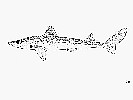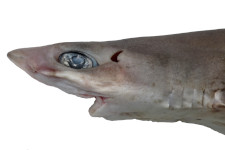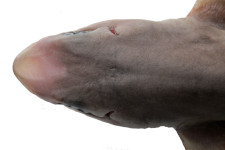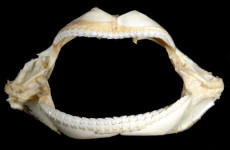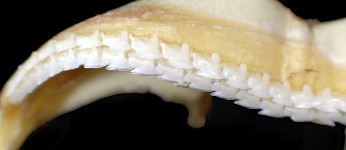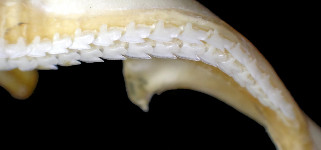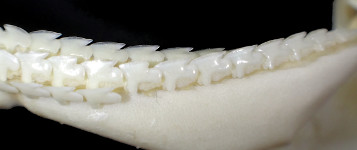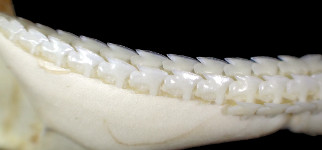Squalus blainville
(Risso, 1827)
Longnose spurdog
Classification: Elasmobranchii Squaliformes Squalidae
Reference of the original description
Histoire naturelle des principales productions de l'Europe méridionale et particulièrement de celles des environs de Nice et des Alpes-maritimes. F.G Levrault, Paris. Vol. 3, 480 pp
Histoire naturelle des principales productions de l'Europe méridionale et particulièrement de celles des environs de Nice et des Alpes-maritimes. F.G Levrault, Paris. Vol. 3, 480 pp
Synonyms / new combinations and misspellings
Acanthias blainville, Acanthias blainvillei, Acanthias blainvilli, Acanthias blainvillii, Acanthias fernandezianus, Spinax blainvillii, Spinax fernandezianus, Squalus aff. blainvillei, Squalus blainvilii, Squalus blainvillei, Squalus blainvillii, Squalus cf. blainvillei
Acanthias blainville, Acanthias blainvillei, Acanthias blainvilli, Acanthias blainvillii, Acanthias fernandezianus, Spinax blainvillii, Spinax fernandezianus, Squalus aff. blainvillei, Squalus blainvilii, Squalus blainvillei, Squalus blainvillii, Squalus cf. blainvillei
Description :
Citation: Squalus blainville (Risso, 1827): In: Database of modern sharks, rays and chimaeras, www.shark-references.com, World Wide Web electronic publication, Version 01/2026
Please send your images of "Squalus blainville" to info@shark-references.com
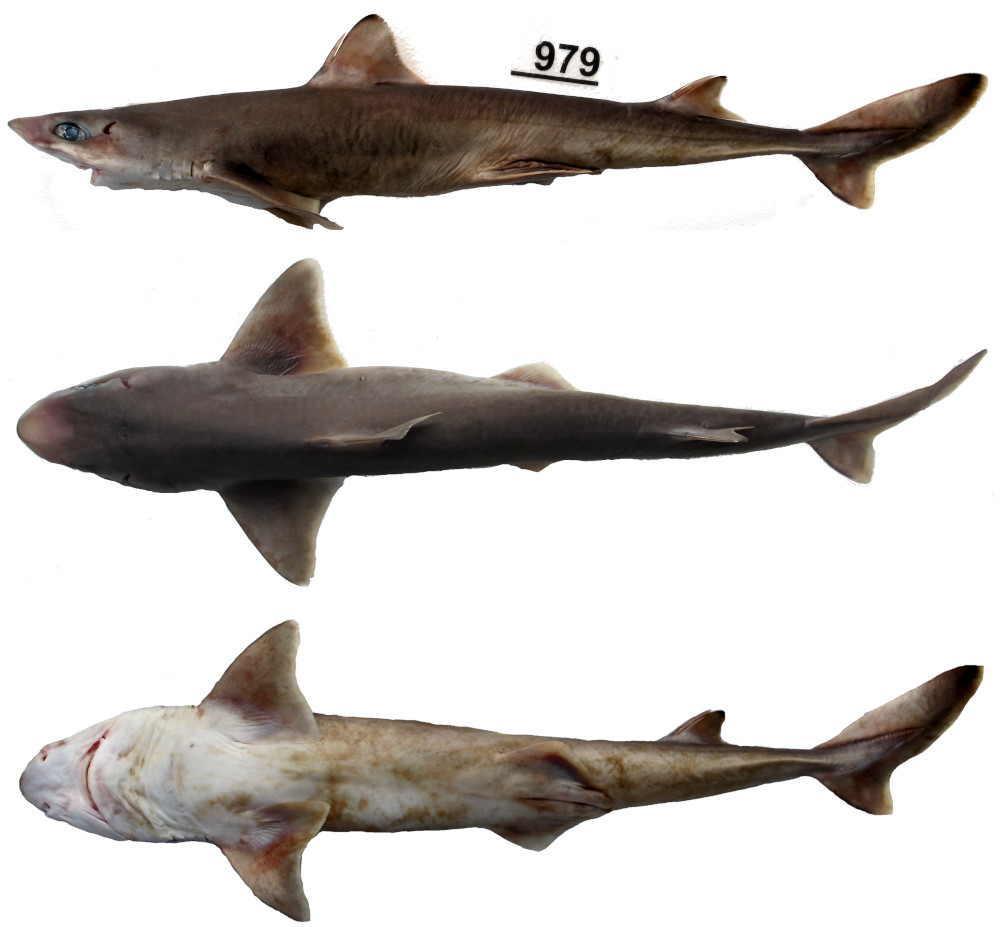
Squalus blainville (Risso, 1827), ERB 0979, male, 54, 5 TL, Mediterranean, France © Frederik H. Mollen (Elasmobranch Research Belgium)

Squalus blainville (Risso, 1827), ERB 0979, male, 54, 5 TL, Mediterranean, France © Frederik H. Mollen (Elasmobranch Research Belgium)
Common names
 Blainville-Dornhai,
Blainville-Dornhai,  Blainvilles Dornhai,
Blainvilles Dornhai,  Blainvilles doornhaai,
Blainvilles doornhaai,  Galludo,
Galludo,  Pinchuo,
Pinchuo,  Aiguillat coq,
Aiguillat coq,  Bigeye dogfish,
Bigeye dogfish,  Dogfish,
Dogfish,  Longnose dogshark,
Longnose dogshark,  Longnose spurdog,
Longnose spurdog,  Spinarolo bruno,
Spinarolo bruno,  Ferranho,
Ferranho,  Galhudo,
Galhudo,  Galhudo-cubano,
Galhudo-cubano,  Melga-de-ferrão, Mazzola bix-xewka (malta), Mazzola tax-xewka (malta)
Melga-de-ferrão, Mazzola bix-xewka (malta), Mazzola tax-xewka (malta)
 Blainville-Dornhai,
Blainville-Dornhai,  Blainvilles Dornhai,
Blainvilles Dornhai,  Blainvilles doornhaai,
Blainvilles doornhaai,  Galludo,
Galludo,  Pinchuo,
Pinchuo,  Aiguillat coq,
Aiguillat coq,  Bigeye dogfish,
Bigeye dogfish,  Dogfish,
Dogfish,  Longnose dogshark,
Longnose dogshark,  Longnose spurdog,
Longnose spurdog,  Spinarolo bruno,
Spinarolo bruno,  Ferranho,
Ferranho,  Galhudo,
Galhudo,  Galhudo-cubano,
Galhudo-cubano,  Melga-de-ferrão, Mazzola bix-xewka (malta), Mazzola tax-xewka (malta)
Melga-de-ferrão, Mazzola bix-xewka (malta), Mazzola tax-xewka (malta)
Short Description
A large dogfish species with a wide head. Moderately long, rounded–parabolic mouth. Preoral length about 1.0 to 1.3 times mouth width. Oblique–cusped cutting teeth in both jaws. Stocky to moderately slender body. Pectoral fins are broad, semifalcate and with slightly concave posterior margins. Two unequal–sized dorsal fins with ungrooved high spines. First dorsal fin very high and short, with slender and very tall spine with spine origin over pectoral inner margins. No anal fin or subterminal notch on caudal fin. Upper precaudal pit and lateral keels on caudal peduncle. No white spots on sides, dorsal fins without conspicuous dark markings, dusky edges and tips, caudal fin without conspicuous dark markings. [17836].
A large dogfish species with a wide head. Moderately long, rounded–parabolic mouth. Preoral length about 1.0 to 1.3 times mouth width. Oblique–cusped cutting teeth in both jaws. Stocky to moderately slender body. Pectoral fins are broad, semifalcate and with slightly concave posterior margins. Two unequal–sized dorsal fins with ungrooved high spines. First dorsal fin very high and short, with slender and very tall spine with spine origin over pectoral inner margins. No anal fin or subterminal notch on caudal fin. Upper precaudal pit and lateral keels on caudal peduncle. No white spots on sides, dorsal fins without conspicuous dark markings, dusky edges and tips, caudal fin without conspicuous dark markings. [17836].
Distribution
Eastern Atlantic: Bay of Biscay to Mediterranean, Morocco, Senegal to Namibia (these records may include other species in addition to Squalus blainvillei). Although reported from the Canary Islands (e.g. Ref. 247), it is most likely based on misidentifications of Squalus megalops [17687]. Western Pacific: southern Japan and Taiwan. Nominal records of Squalus blainvillei or Squalus fernandinus from the western Atlantic (North Carolina, USA to northern Gulf of Mexico; Argentina), Indian Ocean (South Africa, Mozambique, Madagascar, Tanzania and India) and the Pacific (Australia, New Zealand, New Caledonia, Hawaii and northern Chile), as well as some records from the northwest Pacific and eastern Atlantic are based at least in part on Squalus mitsukurii and possibly other species. Whether Squalus blainvillei itself is as wide-ranging as reported for blainvillei-group dogfishes (including Squalus mitsukurii) remains to be determined. Source: www.gbif.org
Eastern Atlantic: Bay of Biscay to Mediterranean, Morocco, Senegal to Namibia (these records may include other species in addition to Squalus blainvillei). Although reported from the Canary Islands (e.g. Ref. 247), it is most likely based on misidentifications of Squalus megalops [17687]. Western Pacific: southern Japan and Taiwan. Nominal records of Squalus blainvillei or Squalus fernandinus from the western Atlantic (North Carolina, USA to northern Gulf of Mexico; Argentina), Indian Ocean (South Africa, Mozambique, Madagascar, Tanzania and India) and the Pacific (Australia, New Zealand, New Caledonia, Hawaii and northern Chile), as well as some records from the northwest Pacific and eastern Atlantic are based at least in part on Squalus mitsukurii and possibly other species. Whether Squalus blainvillei itself is as wide-ranging as reported for blainvillei-group dogfishes (including Squalus mitsukurii) remains to be determined. Source: www.gbif.org
Human uses
fisheries: commercial
fisheries: commercial
Biology
Ovoviviparous, with 3 to 4 young per litter. Young born at about 23 cm.
theMediterranean Sea: S. blainville is a long lived (maximum observedage of 28 yrs), slow growing (k = 0.03 and 0.08 yr−1for femalesand males, respectively) and late maturing species (L50= 568.1 and L50= 460.6 mm for females and males, respectively). Actually, aging 569 individuals revealed that the species attains sexual maturity at a later age than it has been so far known (T50= 17.03 and 11.31yrs for females and males, respectively) [22811].
Ovoviviparous, with 3 to 4 young per litter. Young born at about 23 cm.
theMediterranean Sea: S. blainville is a long lived (maximum observedage of 28 yrs), slow growing (k = 0.03 and 0.08 yr−1for femalesand males, respectively) and late maturing species (L50= 568.1 and L50= 460.6 mm for females and males, respectively). Actually, aging 569 individuals revealed that the species attains sexual maturity at a later age than it has been so far known (T50= 17.03 and 11.31yrs for females and males, respectively) [22811].
Remarks
shark-references Species-ID=6715;
shark-references Species-ID=6715;
Parasites (arranged by Jürgen Pollerspöck)
Conoidasida
Myxosporea
Cestoda
Copepoda
Conoidasida
- Goussia lucida Lom & Dyková, 1982 [32027]
Myxosporea
Cestoda
- Gilquinia nannocephala (Pintner, 1929) [16112]
- Gilquinia robertsoni Beveridge, 1990 [16112]
- Gilquinia squali (Fabricius, 1794) [16251] [16112]
Copepoda
- Achtheinus dentatus Wilson, 1911 [27172]
- Achtheinus oblongus Wilson, 1908 [15303]
- Eudactylina acanthii Scott, 1901 [16609]
- Eudactylina vilelai Nuñes-Ruivo, 1956 [16609]
- Kroyeria carchariaeglauci Hesse, 1878 [16609]
- Trebius sp. [16609]








